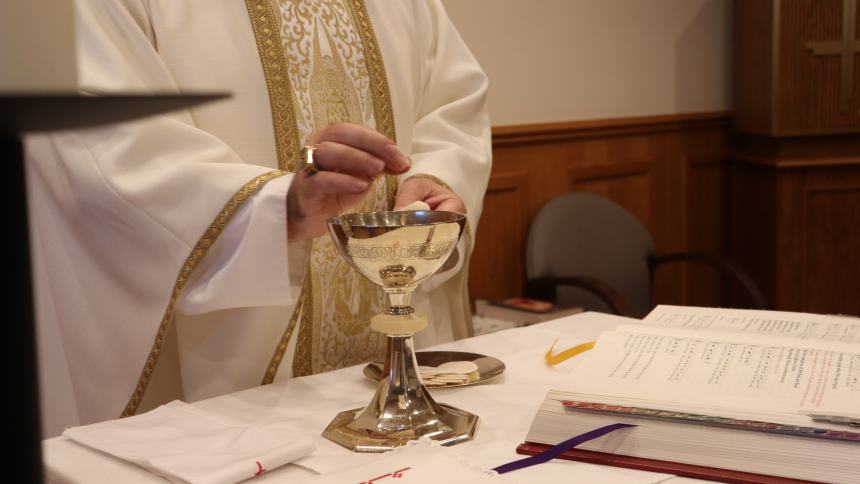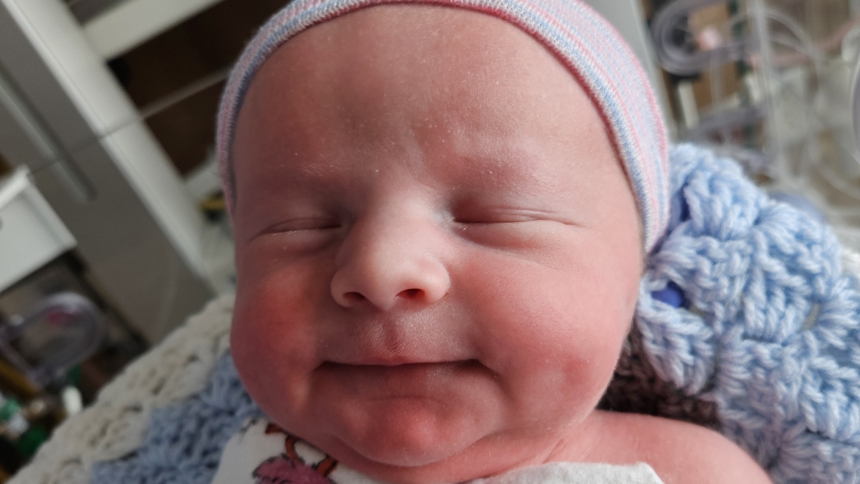
On November 25, 2023, the vigil of the Solemnity of Our Lord Jesus Christ, King of the Universe, the Diocese of Gary will return to the liturgical posture wherein the faithful kneel after the Lamb of God (Agnus Dei). Since my arrival in 2020, many clergy and lay faithful have spoken to me about the desire for our diocese to return to the norm of kneeling so that we are in union with the other dioceses throughout the country. This decision comes after prayerful consideration and with the support of the Priest Council.
For two decades our diocese has adopted the permissible posture of standing after the Agnus Dei and throughout Communion. The General Instruction of the Roman Missal (GIRM) specifically allows for this: “In the Dioceses of the United States of America…The faithful kneel after the Agnus Dei (Lamb of God) unless the Diocesan Bishop determines otherwise.” (cf. GIRM, 43).
Since all the other dioceses around us (and almost all in the United States) follow the US norm of kneeling after the Lamb of God, there are moments of disunity as people from other dioceses come to Mass in our churches and they are confused why everyone else doesn’t kneel. The same confusion happens when our faithful go to Mass in other dioceses.
In light of the Eucharistic Revival, this is a fitting time for us to rediscover how our bodily posture is symbolic of our interior disposition. Standing is an ancient posture of respect, attention and readiness. One stands at attention when the judge enters the court. In Exodus the Israelites are instructed to eat the Passover standing, like people ready to move. We always stand for the Gospel as a sign of reverence for the words of the Lord. Standing is also a posture that has a symbolic connection to the resurrection. For this reason, when praying the Litany of Saints during the Easter Season we stand, while during the rest of the year we kneel.
Depending on the context, kneeling can be considered a penitential sign, but kneeling is also a reverential act toward our Lord: “at the name of Jesus every knee should bend, of those in heaven and on earth and under the earth” (Philippians 2:10).
We believe the liturgy we celebrate here on earth is a participation in the heavenly liturgy. The Book of Revelation describes worship in heaven. While standing is certainly recognized as a posture during worship (Rev. 7:15), when the Lamb of God is presented initially before the throne of heaven, everyone falls down in worship before Him (cf. Rev. 5:1-14).
As we kneel, we acknowledge that Jesus is truly present in the Holy Eucharist, and we kneel down in worship before Him because Jesus is the King of kings and the Lord of lords. That is why it is particularly fitting that we institute this change on the Solemnity of Our Lord Jesus Christ, King of the Universe.
Finally, a word about silence in the liturgy: Silence is a most difficult activity for us today. Our daily life is full of sound, some good, but most just noise of one sort or another. Silence is golden because it allows us to be recollected, to wonder about God’s loving presence in our lives. At Mass we also need time to reflect in silence about the Word proclaimed and the Sacrament received. Some silence after each scripture reading and after the homily and after all have received communion allows each person and the community to collectively reflect on the ever-abiding presence of God in our midst.
Here are some of the practical implications:
After the Agnus Dei (Lamb of God) is sung/spoken, the faithful will kneel, as they are able, until it is time to rise and join in the Communion Procession.
Upon returning to their place after receiving Holy Communion, the faithful are free to kneel, sit, or stand.
When all have received Communion, the faithful are encouraged to kneel or sit for a period of sacred silence and prayer.
The liturgy is a great gift in which we are guaranteed an encounter with Christ. Pope Francis reminds us of the richness of our encounter with the Lord in the Eucharist and all the sacraments:
For us a vague memory of the Last Supper would do no good. We need to be present at that Supper, to be able to hear his voice, to eat his Body and to drink his Blood. We need Him. In the Eucharist and in all the sacraments we are guaranteed the possibility of encountering the Lord Jesus and of having the power of his Paschal Mystery reach us. The salvific power of the sacrifice of Jesus, his every word, his every gesture, glance, and feeling reaches us through the celebration of the sacraments. (Pope Francis, Desiderio Desideravi, 10-13).
My prayer is that this change in posture will enhance our unity and give us a deeper appreciation for the gift of our Lord in the Holy Eucharist.
Your servant,
Most Reverend Robert J. McClory
Bishop
Diocese of Gary
El 25 de noviembre de 2023, vigilia de la Solemnidad de Nuestro Señor Jesucristo, Rey del Universo, la Diócesis de Gary volverá a la postura litúrgica en la que los fieles se arrodillan después del Cordero de Dios (Agnus Dei). Desde mi llegada en 2020, muchos clérigos y fieles laicos me han hablado sobre el deseo de que nuestra diócesis vuelva a la norma de arrodillarse para que estemos en unión con las otras diócesis de todo el país. Esta decisión ha sido tomada después de considerarla en oración y con el apoyo del Consejo Sacerdotal.
Durante dos décadas nuestra diócesis ha adoptado la postura permisible de estar de pie después del Agnus Dei y durante toda la Comunión. La Instrucción General del Misal Romano (IGMR) lo permite específicamente: "En las Diócesis de los Estados Unidos de América...Los fieles se arrodillan después del Agnus Dei (Cordero de Dios) a menos que el Obispo Diocesano determine lo contrario". (cf. GIRM, 43).
Dado que todas las demás diócesis de nuestro entorno (y casi todas las de Estados Unidos) siguen la norma estadounidense de arrodillarse tras el Cordero de Dios, se producen momentos de desunión cuando personas de otras diócesis acuden a Misa en nuestras iglesias y se sienten confusas porque los demás no se arrodillan. La misma confusión ocurre cuando nuestros fieles van a Misa en otras diócesis.
A la luz del renacimiento eucarístico, es un momento oportuno para redescubrir cómo nuestra postura corporal simboliza nuestra disposición interior. Estar de pie es una antigua postura de respeto, atención y disposición. Se está de pie cuando el juez entra en el tribunal. En el Éxodo se ordena a los israelitas que coman la Pascua de pie, como personas dispuestas a moverse. Siempre nos ponemos de pie para escuchar el Evangelio, en señal de reverencia ante las palabras del Señor. Estar de pie es también una postura que tiene una conexión simbólica con la resurrección. Por esta razón, al rezar las letanías de los santos durante el tiempo pascual permanecemos de pie, mientras que durante el resto del año nos arrodillamos.
Según el contexto, arrodillarse puede considerarse un signo penitencial, pero arrodillarse es también un acto reverencial hacia nuestro Señor: "al nombre de Jesús se doble toda rodilla de los que están en los cielos, en la tierra y debajo de la tierra" (Filipenses 2:10).
Creemos que la liturgia que celebramos aquí en la tierra es una participación en la liturgia celestial. El Apocalipsis describe el culto en el cielo. Aunque ciertamente se reconoce la postura de pie durante el culto (Ap. 7:15), cuando el Cordero de Dios es presentado inicialmente ante el trono del cielo, todos se postran en adoración ante Él (cf. Ap. 5:1-14).
Al arrodillarnos, reconocemos que Jesús está verdaderamente presente en la Sagrada Eucaristía, y nos arrodillamos en adoración ante Él porque Jesús es el Rey de reyes y el Señor de señores. Por eso es particularmente oportuno que instituyamos este cambio en la solemnidad de Nuestro Señor Jesucristo, Rey del Universo.
Por último, unas palabras sobre el silencio en la liturgia: El silencio es una actividad muy difícil para nosotros hoy. Nuestra vida cotidiana está llena de sonidos, algunos buenos, pero la mayoría sólo ruido de un tipo u otro. El silencio es oro porque nos permite recogernos, preguntarnos por la presencia amorosa de Dios en nuestras vidas. En la Misa también necesitamos tiempo para reflexionar en silencio sobre la Palabra proclamada y el Sacramento recibido. Un poco de silencio después de cada lectura bíblica y de la homilía, y después de que todos hayan comulgado, permite a cada persona y a la comunidad reflexionar colectivamente sobre la presencia siempre permanente de Dios en medio de nosotros.
He aquí algunas implicaciones prácticas:
Después de cantar el Agnus Dei (Cordero de Dios), los fieles se arrodillarán, si pueden hacerlo, hasta el momento de levantarse y unirse a la Procesión de la Comunión.
Al regresar a su lugar después de recibir la Sagrada Comunión, los fieles son libres de arrodillarse, sentarse o ponerse de pie.
Cuando todos hayan recibido la Comunión, se anima a los fieles a arrodillarse o sentarse para un período de silencio sagrado y oración.
La liturgia es un gran don en el que se nos garantiza el encuentro con Cristo. El Papa Francisco nos recuerda la riqueza de nuestro encuentro con el Señor en la Eucaristía y en todos los sacramentos:
A nosotros no nos serviría de nada un vago recuerdo de la Última Cena. Necesitamos estar presentes en aquella Cena, poder oír su voz, comer su Cuerpo y beber su Sangre. Le necesitamos. En la Eucaristía y en todos los sacramentos se nos garantiza la posibilidad de encontrar al Señor Jesús y de que nos alcance la fuerza de su Misterio pascual. La fuerza salvífica del sacrificio de Jesús, cada una de sus palabras, cada uno de sus gestos, miradas y sentimientos llega a nosotros a través de la celebración de los sacramentos. (Papa Francisco, Desiderio Desideravi, 10-13).
Mi oración es que este cambio de postura mejore nuestra unidad y nos haga apreciar más profundamente el don de nuestro Señor en la Sagrada Eucaristía.
Tu siervo,
Reverendísimo Robert J. McClory
obispo
Diócesis de Gary


